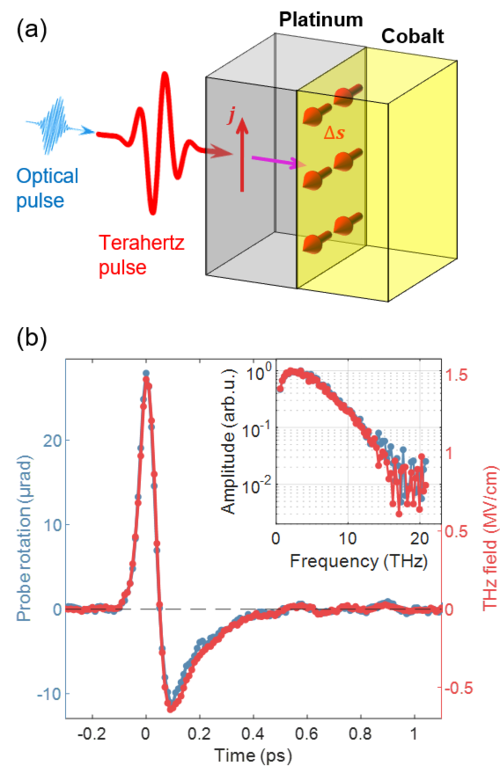How to use spintronics to detect terahertz waves
News from Apr 09, 2025
Using broadband terahertz pulses, researchers at Freie Universität Berlin observed charge-to-spin conversion in the interface region of two nanometer-thin metallic layers at extremely high, terahertz rates. The results enable a new way of detection of terahertz electric fields and provide insight into elusive processes at interfaces.
Part of future information technologies will not only rely on the charge of electrons, but also on their spin. The electron spin is the origin of the magnetic moment of electrons which, similar to a compass needle, can be oriented by a magnetic field. It is used as information carrier in so-called spintronic devices, e.g., magnetic random-access memories.
A spintronic key process is the conversion of a charge current [thin red arrow in Figure 1(a)] into an accumulation of spin (thick red arrow). It happens, in particular, at the interface of a layer of Cobalt, which is a ferromagnet with magnetic moment (gray arrow), and a Platinum layer. This phenomenon is highly important to set the direction of the magnetic moment to or and, thus, write a magnetic bit (1 or 0). So far, spin accumulation was achieved by voltages applied through electrodes which strongly limits the available current rate and speed. However, other information carriers, such as light in optical fibers, routinely work at extremely high rates at 1 terahertz, i.e., one million times one million cycles per second.
To push the speed of spin accumulation to the terahertz range, Dr. Alex Chekhov of the Terahertz Physics Group at the Department of Physics of the Free University Berlin made use of cutting-edge ultrashort electric-field pulses at terahertz (THz) frequencies to drive the ultrafast charge current in the Cobalt-Platinum stack (figure 1a). To monitor the temporal evolution of the resulting spin accumulation, Alex made use of an additional optical pulse with controllable time delay.
This experiment led to 3 discoveries. First, and very surprisingly, the measured signal [Figure 1(b)] turned out to look exactly like the electric field of the driving terahertz pulse. “At first, I couldn’t believe my eyes: It was directly the driving pulse, which I was never able to detect without distortion. This observation immediately meant that such process can serve as a broadband terahertz detector,” says Alex Chekhov. Indeed, the detection of such short and, thus, broadband pulses is challenging, since almost always the detection process is frequency-dependent.
“Second, the extremely fast response of the sample also allowed us to identify the mechanism behind the observed ultrafast spin accumulation: the so-called Rashba-Edelstein effect. Such identification is hard with other methods. Third, the spin accumulation is localized at the very interface of the Cobalt and Platinum layers.” Therefore, the technique developed here may enable a novel way to probe the terahertz dynamics of electrons, spins and ions at interfaces, which are ubiquitous in physics, chemistry and even biology, but notoriously hard to observe.
Figure description: Fig. 1(a) A terahertz electric field (red waveform) drives a charge current in a 6-nanometer-thin Platinum-Cobalt stack. Spin-to-charge conversion leads to an accumulation of electron spins (red arrows) at the interface of the 2 layers. This accumulation is monitored by a subsequently arriving optical pulse. (b) Measured spin-accumulation signal (blue) versus the driving terahertz electric field (red). The inset shows spectra of the signals and the large bandwidth of 1-20 terahertz.
Original publication:
- Alexander L. Chekhov, Yannic Behovits, Julius J.F. Heitz, Maria-Andromachi Syskaki, Samridh Jaiswal, Oliver Gueckstock, Bruno R. Serrano, Amon Ruge, Jana Kredl, Martin Wolf, Markus Münzenberg, Gerhard Jakob, Mathias Kläui, Tom S. Seifert, Tobias Kampfrath
Distortion-free sampling of ultrabroadband terahertz electric fields by interfacial spin accumulation
Science Advances 11, eadq7741 (2025)
